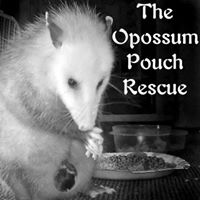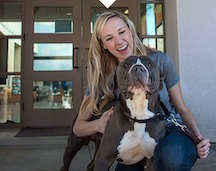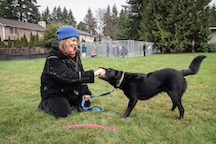Opossum Rescue Group Helps The Misunderstood Marsupial
Beth Sparks, The Opossum's Pouch Rescue
 There are 'opossums' and then there are 'possums.' Opossums have long, pointy noses and a hairless tail. Possums have more of a round face and have a furry tail. Opossums are found in North America, while possums are found in Australia. However, they are both marsupials, with the opossums being the only marsupial in North America.
There are 'opossums' and then there are 'possums.' Opossums have long, pointy noses and a hairless tail. Possums have more of a round face and have a furry tail. Opossums are found in North America, while possums are found in Australia. However, they are both marsupials, with the opossums being the only marsupial in North America.
Beth Sparks heads up The Opossum's Pouch Rescue. This seems a little strange, as most people think of an opossum as a pest and sometimes just road kill.
Beth explains it's a big world for opossums out there. She takes in the orphans that either fall off mom's back or rescues them when mom gets killed in the road. When a mother opossum passes, the babies are still in her pouch and are in need of rescue. They also go on rescues after receiving phone calls from some people who think they have a giant rat in their garage and they want it removed.
A lot of these opossums are also injured in dog attacks. This happens a lot, because they go in looking for a morsel of food left out by the owners for their dogs. Beth also offers medical attention to those that are injured by cars. Fortunately the state of South Carolina, where Beth's rescue is located, allows for non-releasables. Beth explains that all laws are different depending on what state you are located in. Beth has even received opossum as far away as Washington State, with the proper paperwork. So they rescue them from everywhere. She says no one else will take them, so she makes the proper arrangements to get them to South Carolina.
An opossum's pregnancy lasts 13 days. After the babies are born, they make their way into the pouch just like a kangaroo. This is where they will stay for an average of two and a half months. When their eyes open, they start coming out of the pouch a little bit while mom sleeps in. As they get older, they no longer fit in the pouch and it's their instinct that they then ride on her back.
Beth explains that the average size of a litter, if you have a small female, is going to be about 7 to 8. But when you have a larger female, she can have up to 13. However, the average litter is going to be around 9 to 10. She tells us she did see a litter of 14 last year. She explains that there are only 14 teats on a mom, so that's all she can have. Their teats are also in a circle. They're not like your dog or cat that have them in a row. The little baby puts a sort of vapor lock on the mom and they stay fully attached until they're old enough to where they can break loose their suckle and then they start riding on the mother's back.
 Removing them from the pouch can be a little bit difficult, according to Beth. It's almost like kicking an 18-year-old out of the house!
Removing them from the pouch can be a little bit difficult, according to Beth. It's almost like kicking an 18-year-old out of the house!
An opossum reaches maturity at around 6 months of age. In the wild they may live only 12 to 18 months, which is an incredibly short amount of time of less than two years. In captivity, they can live up to four years.
Beth's goal is to rehabilitate them and get them ready to be released back into the wild. But why release them back into the wild if they will have a shorter lifespan? Beth explains that the only other have option is to just let them die, which is not an option in her world. They currently have 38 opossums that are not releasable at the rescue right now. Beth also has 16 in her home. However, their turnover is so quick because of their short lives. This allows her to rescue and take in a lot more. Beth explains that if you rescued squirrels, that might live 12 to 14 years, the numbers would start mounting up because they liver longer, which would makes it a lot harder. But opossums have a short life span and have a very, very hard life in the wild. Beth feels that out of all the wildlife there is, they're at the bottom of the totem pole.
Beth explains that while there are not a lot of opossum rescues in the country, there are a lot of rehabbers who specialize in only opossums. Beth originally started out with another rescue and they rescued a little bit of everything. But she states that opossums get in your blood. They're the underdog and she's always been one for the underdog.
Beth doesn't believe that people should take in wild animals and state laws don't allow it in many places. However, she had an older opossum that came in as a rescue that found in a man's garage. This opossum was blind. She explains that they take to cages quite well, because they're so happy to get out of the elements and the hard lifestyle. If they have a hammock, or a bed and a bowl of food and a place to go potty, they're great. Only because Beth was running short on cages, this opossum took up residence in her kitty bed in a closet. When he came out, he used a stand up shower to go to the bathroom. This made Beth's life very simple. Opossums like to relieve themselves in water. So training them to go potty in a stand up shower or your bathtub is very simple to do. They will take to litter training very easily. Opossums are nocturnal. Even if they are hand raised since a baby, they tend to get on a nocturnal cycle. They also love running on a wheel. They don't play like other mammals but they love an exercise wheel. Because of this, Beth keeps an oilcan handy with some Wesson Oil just to keep her wheels oiled so she can sleep at night.
Beth states that opossums are quite lovely pets and they're either your thing or they're not. Currently there are about probably eight to ten Facebook groups consisting of nothing but people who have an opossum as a pet or opossum rehabbers, and they're growing daily.
 Dr. Debbie wants to clarify that Beth is not advocating people to run out bring opossums into their homes so that they can live a longer life span. They are wild animals and they do live outdoors. You wouldn't do this, just like you're not going to start bringing raccoons and wild horses into your home. You can admire and respect them, but Dr. Debbie cautions folks against bringing in wild animals that they aren't prepared to care for and leave that up to the rehabilitators.
Dr. Debbie wants to clarify that Beth is not advocating people to run out bring opossums into their homes so that they can live a longer life span. They are wild animals and they do live outdoors. You wouldn't do this, just like you're not going to start bringing raccoons and wild horses into your home. You can admire and respect them, but Dr. Debbie cautions folks against bringing in wild animals that they aren't prepared to care for and leave that up to the rehabilitators.
Beth explains that there are actually breeders of opossums. Beth is against this, and states that there's a very big breeding farm in Pennsylvania who adopts these little guys out. She's very much against that, because not a lot of information goes out with them.
An opossum's diet is totally different than any other animal. Their medical needs are also different from other animals. They don't get viruses and it's very unlikely will you ever see them with rabies. But they do get bacterial infections. They are also many up for adoption in Florida, where you can actually get a license to have one as a pet. So Beth tries to do a lot of education, because if you're going to have one for whatever reason, she just wants to make sure the little guys are taken care of properly.
Beth tells us that you can train an opossum, but she associates their behavior very similar to a cat. They can be taught different things. They certainly learn where the treat box is located. But for the most part it needs to be their idea, as they are much like a cat.
The Opossum Pouch Rescue is a non-profit organization and has a great Facebook page for their rescue. They accept donations, and not always cash donations. They get a lot of donations of food and supplies. She tells us they just got a freezer and a refrigerator donated for extra food and formula.
Beth reaches out to people all over the world and also does educational outreach for the opossum.
Visit Facebook
The Healing Power of the Paw
Shannon, Kopp, Soul Paws Recovery
 Shannon Kopp is no stranger to Animal Radio. In 2015, she told us about her eating disorder, Bulimia. She was throwing up 20 times a day. It was killing her. No doctor or therapist could help her. Things didn't change until she met a special dog. Now, she's advocating the use of animals to help others suffering from eating disorders.
Shannon Kopp is no stranger to Animal Radio. In 2015, she told us about her eating disorder, Bulimia. She was throwing up 20 times a day. It was killing her. No doctor or therapist could help her. Things didn't change until she met a special dog. Now, she's advocating the use of animals to help others suffering from eating disorders.
Things changed when Shannon got a job working with the shelter dogs in San Diego and was their marketing coordinator. Essentially her job was to get to know the homeless dogs. These included lots of Pit bulls and Chihuahuas, as well as mixed breeds and some other purebreds too.
Part of her job was to take them on local news stations, radio stations and to fairs to introduce them to the world. Her job essentially was to spend eight hours a day with these loving shelter dogs. She got this job right out of treatment. She had been hospitalized and went to rehab. This was her eighth year with bulimia. She was really beginning to think that she was a hopeless case. She continued to work with a therapist whose recommendations were nothing Shannon could ever follow through with. She tells us it's a hard thing to explain, but the urges to binge and to purge were so strong that she could never do any other coping mechanism than that.
One day while working at the San Diego Humane Society, Shannon was bingeing in the break room on a bunch of sweets the volunteers had made. In her head, she said she could hear her therapist's voice say, "Can you commit to going to see a shelter dog?" Shannon states it was the first time ever in eight years a thought like that interrupted her binge. She immediately walked out of that break room. To the right was the bathroom and to the left the dog kennels. She went right to the dog kennels and sat with this big dog named Paloma. They had nicknamed her Kim K, because she had a really big butt. She had been hit by a car and she was doing great. However, one of her back legs was shorter than the other so she had this adorable little strut when she walked. She's was a big white loving pit bull.
Shannon went into that that kennel feeling horrible and full, uncomfortable and hopeless. That dog, completely unaware of her size, sat on Shannon's lap for 30 minutes and grounded her. Shannon held on to the dog, stroked her fur and looked into her eyes. Shannon let Paloma kiss and slobber all over her. She didn't get up and leave that kennel until she was confident she wasn't going to purge. That was the beginning of Shannon's recovery.
 Shannon learned to turn to these animals who would never judge her; who would never give her a lecture; that had no expectations and didn't care what she did the night before. They just loved her and they were so happy to see her. Shannon couldn't believe this, because at that point she was so convinced she was unlovable but these animals accepted her in the most profound way.
Shannon learned to turn to these animals who would never judge her; who would never give her a lecture; that had no expectations and didn't care what she did the night before. They just loved her and they were so happy to see her. Shannon couldn't believe this, because at that point she was so convinced she was unlovable but these animals accepted her in the most profound way.
Shannon began turning to them when she was having purging urges and it worked. It's been eight years now and she is in full recovery from bulimia. Shannon continues to work with shelter dogs and even has her own rescue dog, Bella, who continues to help her.
When we last spoke to Shannon, her book, "Pound for Pound" had just come out, which was such an incredible experience for her. She connected with people all over the world about the healing power of the paw. She also founded a non-profit called Soul Paws Recovery Project. Essentially they offer free animal assisted therapy to people impacted by eating disorders in San Diego. So every month they have miniature horses, dogs, puppies, rabbits, guinea pigs and even rats sometimes in their workshop, available to anyone that's struggling with food and body issues.
The beginning of every New Year is hard, explains Shannon, especially when everyone is bombarded by messages about changing their body and becoming a new improved version of themselves. The message at Soul Paws is that animals love us just as we are. We are perfect just as we are. They offer different exercises with these animals that have had a really profound impact on people of all ages.
Beth tells us about one woman came to them in her 50s and said she'd never asked for help for her eating disorder before. However, the idea of coming to a room filled with therapy dogs was a lot easier than going into a therapist's office. So sometimes it's easier to start with the animals telling them the truth and practicing truth telling. This makes it easier to get rid of the shame and then to build up to speaking perhaps with a therapist or maybe even going into treatment. You might even find a treatment center that incorporates animal assisted therapy.
Shannon said it took a long time for her to even admit that she had an eating disorder, which she calls "food and body issues." If you're struggling with accepting your body, if your mind is focused and stressed out over food, then Soul Paws is a good place for you. You may even have your own animal that can help you through therapy. However, most of the people that come to Shannon are actually coming from treatment centers. So they are being hospitalized or are currently in a treatment center. Sometimes this can be for a long time, like weeks or month, some even years. So they're away from their family pets; they're away from those animals that they love so much. These animals are really important and special for them. Some people are just in the situation that she was in. The first year she worked at the San Diego Humane Society, she thought she was the only person there that did not have a pet. This wasn't because she wasn't dying to have one, but she could barely take care of herself. So she did not want to put another life at risk. Her life was already at risk.
Soul Paws is a part of the treatment process for people, in addition to their outpatient therapy and treatment. So they're not in a place yet where they can adopt a dog of their own. They come to Soul Paws for healing and companionship. And then of course there are those that have animals at home. What they can do at Soul Paws is to learn different meditation practices and different therapeutic exercises that they can then take home with them and practice with their own pets.
One success story that Shannon tells us about is someone she met when she was in treatment. This woman told Shannon she struggled with bulimia, exercise addiction and substance use. She told Shannon that she was thinking about leaving treatment. She was in her early 30s and had just checked in when the resident therapy dog climbed into her lap and convinced her to stay. She ended up staying and completed her treatment, making incredible progress. And then when she was discharged, she was really frightened. She was terrified that she was going to relapse without that structure and support. So she adopted a dog of her own and started coming to Soul Paws. She has now been coming for a year and recently signed on as a board member with Soul Paws. She is doing great in her recovery. She's actually going to school now and her life has been transformed. She claims that Soul Paws is a really important part of that.
 She also tells us about another woman who struggled with a binge eating disorder and went to treatment. This woman claims that there's not a place in the world she feels safer than when she's at Soul Paws with the animals and with other people who really understand what she's going through.
She also tells us about another woman who struggled with a binge eating disorder and went to treatment. This woman claims that there's not a place in the world she feels safer than when she's at Soul Paws with the animals and with other people who really understand what she's going through.
There are a lot of different stories and Shannon is just so excited to be a part of it. She's so excited to share what she discovered at the San Diego Humane Society with others and to watch animals do their magic, which is really lovely. The way they love us, the way they make us feel, is so unconditional and it saves lives.
Shannon thinks that when you're dealing with eating disorders, there's so much shame, there's so much compulsive obsessive thinking, that it's really a healing experience to be with an animal that will not trigger your shame. Even if you have loving people in your life, like Shannon's therapist was with her, she still struggled to be honest with her about her eating disorder. Shannon would have never admitted to her therapist, as great as she was, and they worked together for 10 years, that she was struggling and throwing up 20 times a day. Shannon never told her because she was so ashamed. However, she could tell a dog and that was the bridge for her. Eventually she would go on and tell her therapist. But the shame was almost palpable. It was something that really prevented her recovery. And so it makes sense to her that animals are going to love us no matter what, particularly shelter dogs that are just desperate for love. It's a really powerful thing.
Shannon has also joined forces with the Eating Recovery Center. They have treatment centers all across the country treating anorexia, bulimia and binge eating disorders. She's been sharing her message of hope and recovery and obviously talking a lot about the healing power of the paw, which is a big part of her story.
This has been an incredible journey and Shannon is looking to expand Soul Paws.
Visit Website
When Pet Food Is Medicine - Dr. Debbie
 Proper pet nutrition is more than just diet choices for the healthy pet. It's even more important to properly feed the sick pet or those with chronic diseases. What you put in your pet's food bowl can help, or harm, his ability to cope with illness.
Proper pet nutrition is more than just diet choices for the healthy pet. It's even more important to properly feed the sick pet or those with chronic diseases. What you put in your pet's food bowl can help, or harm, his ability to cope with illness.
Peek into your average veterinary office and you'll likely find one or more brands of therapeutic diet foods created to manage pet specific pet health conditions. Veterinarians prescribe therapeutic diets to help pets with kidney disease, diabetes, pancreatitis, weight loss or heart disease. Special digestive diets may focus on hypoallergenic ingredients, fiber content or fat levels. Some diets prevent or dissolve mineralized stones in the urinary bladder. There are even diets to keep the spring in your arthritic dog's step and diets to aid in treating pets with cancer.
The grandfather of veterinary nutrition was Dr. Morris who in 1940 designed a diet to improve longevity of his dog, Buddy, who was a seeing-eye dog battling kidney disease. His efforts led to the introduction to Hill's K/D diet, a favorite diet used today for dogs and cats with kidney dysfunction. Today many more diets and conditions are addressed by companies such as Science Diet, Royal Canin, Purina and Iams.
As a veterinarian I recognize the value that therapeutic diets lend to managing my patients' health. But my strongest testament to their value is as a doggie momma who feeds a therapeutic diet to my own dog, Magnum.
My Labrador Magnum suffers from food allergies with frequent facial skin infections, bad skin odor, scratching and unpleasant gastrointestinal signs with diarrhea and flatulence. After several diet trials with various hypoallergenic diet approaches, he now thrives on a rabbit based therapeutic diet by Royal Canin. His doggie kisses are sweeter smelling now, he's content and he isn't a walking gaseous explosion anymore.
 But be prepared to dig deeper in your wallet for therapeutic diets. The research behind these foods will cost the consumer more than average pet foods. Just look at the example of Magnum's food. This diet runs $86 for a 25-pound bag of dry food. This sure isn't cheap. But the investment can pay off in lower medical costs and fewer veterinary visits, justifying the additional cost. In Magnum's case, we are able to avoid continued treatment of skin infections, thereby avoiding medication use and he is spared incessant itching.
But be prepared to dig deeper in your wallet for therapeutic diets. The research behind these foods will cost the consumer more than average pet foods. Just look at the example of Magnum's food. This diet runs $86 for a 25-pound bag of dry food. This sure isn't cheap. But the investment can pay off in lower medical costs and fewer veterinary visits, justifying the additional cost. In Magnum's case, we are able to avoid continued treatment of skin infections, thereby avoiding medication use and he is spared incessant itching.
Some pet owners turn to home cooked diets in order to avoid the costs of therapeutic diets. Without guidance and veterinary nutrition analysis, pet owners may risk shortchanging their pet's nutrition. One research study identified that over 90-percent of home prepared diets for sick pets failed to be nutritionally adequate. Quality ingredients aren't cheap and a well-produced home cooked diet often ends up costing far more to prepare than commercially produced therapeutic diets.
If your veterinarian recommends nutritional management with a therapeutic diet, discuss all the options with your doctor. Inquire about different brands and sizes of food packages available, as many options are available. Get your money's worth on these diets by following your veterinarian's recommendations. Avoid mixing therapeutic diets with regular foods. This only hinders your pet's results and give you a false sense of saving money by making the food last longer.
As for Magnum, I choose to feed him his therapeutic diet and avoid popping pills into him. That's my gauge of a therapeutic diet success - food that serves like medicine in the doggie bowl, but without the hassles.
Featured veterinarian known as "Dr. Debbie" on national pet radio program, Animal Radio. Ebook author of "Yorkshire Terriers: How to Be Your Dog's Best Friend"; "Pugs: How to Be Your Dog's Best Friend"; "Mini Schnauzers: How to Be Your Dog's Best Friend"; and "Shih Tzu: How to Be Your Dog's Best Friend." Dr. Debbie's books.
Visit Website
Animal Radio News - Lori Brooks
 Fine for Fake Service Dogs
Fine for Fake Service Dogs
An Arizona state lawmaker has introduced a bill that will fine people up to $250 if they're caught trying to pass their pets off as service animals in public places. As much as this problem irritates many people, some disability advocates worry that if State Senate Bill 1040 becomes law, it may cause more problems and misunderstandings. According to an attorney with the Arizona Center for Disability Law, current federal law says business owners are only allowed to ask people with service animals two questions: 1. Is your animal a service animal that's required for your disability? 2. What task or work has your service animal been trained to do? Those business owners cannot ask people for proof that an animal is in fact a certified service animal. Business owners are also not allowed to force or request pet owners to demonstrate their pet's skills. However, those business owners are allowed to ask people to leave if their service animal is behaving in a threatening way, going to the bathroom inside the establishment, or causing an unnecessary distraction for other patrons, which a real service animal would never do.
 Goldfish Survive California Fires
Goldfish Survive California Fires
The fires late last year in California affected a lot of pets and people, but what a group of young men found in the scorched remains of a neighborhood wasn't a photo album, wedding ring or even a skittish cat separated from its family. What Logan Hertel and a few of his friends discovered were goldfish. Somehow the fish had survived a fire in a bathtub in someone's backyard. That fire had wiped out many homes in the neighborhood so for now, the 21-year-old student has set up an aquarium for them at his father's home and his mother has helped and posted signs of Hertel with the fish around the burned out neighborhood.
Cats Kill Millions of Birds Every Day
In Australia, it's estimated that cats kill more than 1 million birds every single day. In one research project, scientists did a review of 100 previous studies that were conducted across the continent. They found that 316 million birds are killed by feral cats every year in Australia and another 61 million birds are killed by pet cats. The worst part is that more than 300 species of birds are impacted and 71 of those are bird species, which are already threatened. It's not just the small birds that are the targets either. Scientists say medium sized birds are most likely to be killed by feral cats.
 Judges Decide Pet Custody
Judges Decide Pet Custody
Divorcing couples in Illinois who can't agree on who keeps the pets will have a judge decide custody, thanks to a new state law. Usually companion animals are treated like property to be divided up between the couple, because in most states pets are still classified as property. But now with the rise of two-income families opting not to have children, the issue of pet custody is gaining more attention. Under the new law, which went into effect the first of the year, Illinois judges will now have clear guidance when they must decide whether to award sole custody to one pet parent or rule that they must share custody. Factors will include things like who takes care of the pet on a day-to-day basis and who spends more money on things like food health care. Last year Alaska became the first state in which judges added pet custody to their dockets.
 Denver Bans Cat Declawing
Denver Bans Cat Declawing
Denver has become the first city in Colorado to ban elective cat declawing. The city has decided to prohibit veterinarians from performing the procedure unless it's medically necessary. That makes Denver the first major U.S. city outside of California to make this move after passing the bill in November. However, the Colorado Veterinary Medical Association opposes the measure saying the decision to declaw a cat or not should be left up to a veterinarian and the pet owner. But, like many veterinarians around the country, most simply do not offer the surgery any longer.
 Off-Leash Park For Pets of Homeless Women
Off-Leash Park For Pets of Homeless Women
A non-profit group called Fences for Fido has built an off-leash dog park for pets that belong to homeless women. Volunteers put up the fencing recently at a church in Washington State. The church runs a "Safe Parking" program, allowing 40-50 women and families to stay in cars in the church parking lot. The Portland based Fences for Fido says it was important for them to step up to help the women keep their pets, since the church was already allowing them to use their kitchen and Wi-Fi.
 Listen to the entire Podcast of this show (#946)
Listen to the entire Podcast of this show (#946)





